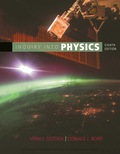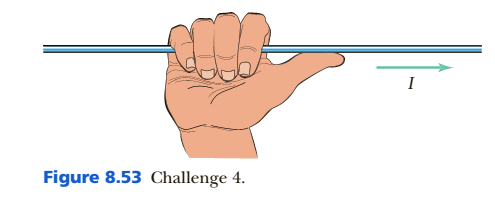
Concept explainers
The right-hand rule is a way to determine the direction of the magnetic field produced by moving charges. Imagine wrapping your right hand around the path of the charges so that the positive charges (or the current) flow from the little finger side of your fist to the thumb side (Figure 8.53). Then your fingers circle the path in the same direction as the magnetic field lines. Use this rule to verify the directions of the magnetic fields shown in Figures 8.8 and 8.10. How would you use the rule to find the direction of the magnetic field lines around a moving negative charge?

Trending nowThis is a popular solution!

Chapter 8 Solutions
Inquiry into Physics
Additional Science Textbook Solutions
Essential Cosmic Perspective
Glencoe Physical Science 2012 Student Edition (Glencoe Science) (McGraw-Hill Education)
The Physical Universe
University Physics (14th Edition)
Physics for Scientists and Engineers: A Strategic Approach, Vol. 1 (Chs 1-21) (4th Edition)
Conceptual Physics: The High School Physics Program
- In Niels Bohr’s 1913 model of the hydrogen atom, the single electron is in a circular orbit of radius 5.29 × 10−11 m and its speed is 2.19 × 106 m/s. (a) What is the magnitude of the magnetic moment due to the electron’s motion? (b) If the electron moves in a horizontal circle, counterclockwise as seen from above, what is the direction of this magnetic moment vector?arrow_forwardAn electron in a TV CRT moves with a speed of 6.0107 m/s, in a direction perpendicular to Earth's field, which has a strength of 5.0105 T. (a) What strength electric field must be applied perpendicular to the Earth’s field to make the election moves in a straight line? (b) If this is done between plates separated by 1.00 cm, what is the voltage applied? (Note that TVs are usually surrounded by a ferromagnetic material to shield against external magnetic fields and avoid the need for such a collection,)arrow_forwardThe magnetic dipole moment of the iron atom is about 2.11023Am2 . (a) Calculate the maximum magnetic dipole moment of a domain consisting of 1019 iron atoms, (b) What current would have to flow through a single circular loop of wire of diameter 1.0 cm to produce this magnetic dipole moment?arrow_forward
- The magnitude of the magnetic field 50 cm from a long, thin, straight wire is 8.0T . What is the current through the long wire?arrow_forwardTwo long wires, one of which has a semicircular tend of radius R, are positioned as shown in the accompanying figure. If both wires carry a current I, how far apart must then parallel sections be so that the net magnetic field at P is zero? Does the current in the straight wire flow up or down?arrow_forward(a) An oxygen16 ion with a mass at 2.661026kg travels at 5.00106m/s perpendicular to a 1.20T magnetic field, which makes it move in a circular arc with a 0.231-m radius. What positive charge is on the ion? (b) What is the radio of this charge to the charge of an electron? (c) Discuss why the radio found in (b) should be an integer.arrow_forward
- A circular parallel-plate capacitor whose plates have a radius of (5.640x10^1) cm is being charged with a current of (2.1x10^1) A. What is the magnetic field (9.660x10^0) cm from the center of the plates? Express your result in UT with two significant figures.arrow_forwardA moving electron travels along the path shown, and passes through a region of magnetic field. There are no other charges present. The magnetic field is zero everywhere except in the gray region. Choose from the following directions to answer the question below: What is a possible direction (a – g) of the magnetic field in the region where the field is non-zero?arrow_forwardFor Lab #7, a wire segment is placed between the poles of a magnet with the segment perpendicular to magnetic field. The magnet is placed on a scale such as to measure the magnetic force produced. The scale reads 0.00 g when no current passes through the wire. The length of the wire segment is 2.0 cm. When a 2.0 A current passes throught the wire, the scale reads 0.45 g. What is the strength of the magnetic field in mT? (Hint: The magnetic force will be mg, where m is the scale reading.)arrow_forward
- Consider a circular ring of radius r as shown in figure 3, through which a current i passes: (I need the answer only of the letter d-) and e-) please)a) Calculate the magnetic field along the central axis, x.b) Calculate the magnetic fields at the center, O, and a point far away from the ring on the x-axis.c) Graph the magnitude of the magnetic field B (x) as a function of x.d) Calculate at what distance r measured from the center, the derivative of the magnetic field is constant. Calculate the magnetic field at this position.e) The Helmholtz coils consist of two coils of equal radii separated by the distance 2r calculated in d), through which a current i circulates as shown in figure 4. Calculate the magnitude of the magnetic field at point P equidistant from the coil.arrow_forwardAn iron (density ρ) rod with length L, cross sectional area A, spans across two parallel, metal train tracks. The tracks are connected to a power supply and have a potential ∆V across them. Between the tracks are placed magnets such that the B-field points directly upwards with strength B. What is the acceleration of the iron rod be the moment it starts from rest? What will acceleration be as a function of speed as it continues? Assume the contact is frictionless between the tracks and the rod so that no force of friction needs to be overcome. What will the top speed of the rod be under these conditions?arrow_forwardYou have learned that a charge moving in an magnetic field can experience a magnetic force. Remarkably, anytime that a charged particle moves that particle produces its own magnetic field! The image below of magnetic compasses forming a circle around a current-carrying wire demonstrates the shape of the magnetic field. The magnetic field lines forms concentric circles around that wire. The strength of the field decreases with increasing distance away from the wire. If the current in the wire is 1.97A, what is the magnitude of the magnitude of the magnetic field (in µT, or micro-Tesla) a distance of 0.74m away from the wire? Note: It is understood that the unit of your answer is in uT, however do not explicitly include units in your answer. Enter only a number. If you do enter a unit, your answer will be counted wrong.arrow_forward
 Glencoe Physics: Principles and Problems, Student...PhysicsISBN:9780078807213Author:Paul W. ZitzewitzPublisher:Glencoe/McGraw-Hill
Glencoe Physics: Principles and Problems, Student...PhysicsISBN:9780078807213Author:Paul W. ZitzewitzPublisher:Glencoe/McGraw-Hill
 Principles of Physics: A Calculus-Based TextPhysicsISBN:9781133104261Author:Raymond A. Serway, John W. JewettPublisher:Cengage Learning
Principles of Physics: A Calculus-Based TextPhysicsISBN:9781133104261Author:Raymond A. Serway, John W. JewettPublisher:Cengage Learning College PhysicsPhysicsISBN:9781938168000Author:Paul Peter Urone, Roger HinrichsPublisher:OpenStax College
College PhysicsPhysicsISBN:9781938168000Author:Paul Peter Urone, Roger HinrichsPublisher:OpenStax College Physics for Scientists and Engineers: Foundations...PhysicsISBN:9781133939146Author:Katz, Debora M.Publisher:Cengage Learning
Physics for Scientists and Engineers: Foundations...PhysicsISBN:9781133939146Author:Katz, Debora M.Publisher:Cengage Learning




